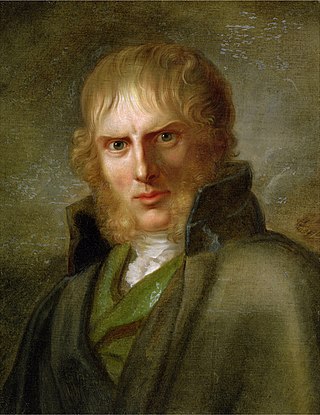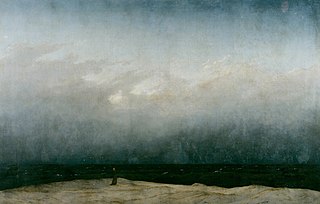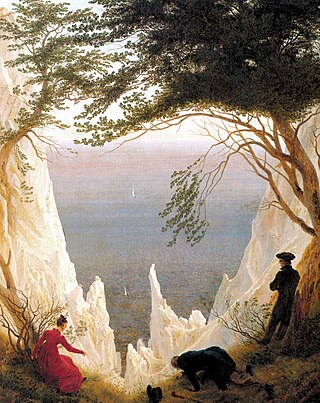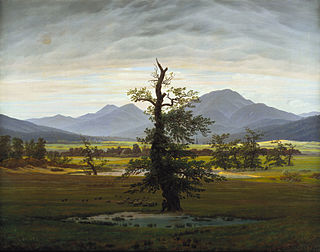
Caspar David Friedrich was a German Romantic landscape painter, generally considered the most important German artist of his generation. He is best known for his allegorical landscapes, which typically feature contemplative figures silhouetted against night skies, morning mists, barren trees or Gothic ruins. His primary interest was the contemplation of nature, and his often symbolic and anti-classical work seeks to convey a subjective, emotional response to the natural world. Friedrich's paintings characteristically set a human presence in diminished perspective amid expansive landscapes, reducing the figures to a scale that, according to the art historian Christopher John Murray, directs "the viewer's gaze towards their metaphysical dimension".

The Royal Danish Academy of Fine Arts has provided education in the arts for more than 250 years, playing its part in the development of the art of Denmark.

Wanderer above the Sea of Fog is a painting by German Romanticist artist Caspar David Friedrich made in 1818. It depicts a man standing upon a rocky precipice with his back to the viewer; he is gazing out on a landscape covered in a thick sea of fog through which other ridges, trees, and mountains pierce, which stretches out into the distance indefinitely.

Georg Friedrich Kersting was a German painter, best known for his Biedermeier-style interior paintings and his association with fellow artist Caspar David Friedrich.

The Stages of Life is an allegorical oil painting of 1835 by the German Romantic landscape painter Caspar David Friedrich. Completed just five years before his death, this picture, like many of his works, forms a meditation both on his own mortality and on the transience of life.

The Monk by the Sea is an oil painting by the German Romantic artist Caspar David Friedrich. It was painted between 1808 and 1810 in Dresden and was first shown together with the painting The Abbey in the Oakwood in the Berlin Academy exhibition of 1810. On Friedrich's request The Monk by the Sea was hung above The Abbey in the Oakwood. After the exhibition, both pictures were bought by king Frederick Wilhelm III for his collection. Today, the paintings hang side by side in the Alte Nationalgalerie, Berlin.

Chalk Cliffs on Rügen is an oil painting of circa 1818 by German Romantic artist Caspar David Friedrich.

The Abbey in the Oakwood is an oil painting by Caspar David Friedrich. It was painted between 1809 and 1810 in Dresden and was first shown together with the painting The Monk by the Sea in the Prussian Academy of Arts exhibition of 1810. On Friedrich's request The Abbey in the Oakwood was hung beneath The Monk by the Sea. This painting is one of over two dozen of Friedrich's works that include cemeteries or graves.

The Sea of Ice, (1823–1824), is an oil painting that depicts a shipwreck in the Arctic by the German Romantic painter Caspar David Friedrich. Before 1826 this painting was known as The Polar Sea.

Mountain Landscape with Rainbow (1809-10), is an oil painting by the German Romantic artist Caspar David Friedrich. Depicting a traveler who has stopped to view a mountainous landscape with a rainbow shining above, the painting was inspired by Friedrich's travels through Germany and along the shores of the Baltic Sea in 1809. Influenced by the Romantic values of subjective experience, Friedrich portrays a figure enraptured by the sublimity of nature.

The Tree of Crows is an oil painting of 1822 by the German Romantic artist Caspar David Friedrich. Acquired by the Musée du Louvre in 1975, it has been called one of Friedrich's "most compelling paintings." The painting depicts a twisted oak tree, bare but for a few dead leaves, seen against an evening sky. An inscription on the back of the canvas refers to the hill at the painting's center as a Hünengrab, or dolmen, a prehistoric burial ground. In the distance can be seen the ocean, and Cape Arkona's chalk cliffs, a favorite subject of Friedrich's. Two crows are perched on the oak, while a flock descends toward it. In the darkened foreground are a hacked trunk and the upright stump of another oak.

Two Men Contemplating the Moon and Man and Woman Contemplating the Moon are a series of similar paintings by Caspar David Friedrich, the setting being among his best-known works. Friedrich painted at least three versions, with one variation featuring a man and a woman. The 1819–20 version in the Galerie Neue Meister is thought to be the original; the c. 1824 variant with a woman is in the Alte Nationalgalerie; and the c. 1830 version is in the Metropolitan Museum of Art.

The Lonely Tree is an 1822 oil-on-canvas painting by German painter Caspar David Friedrich. It measures 55 × 71 centimetres (22 × 28 in). The work depicts a panoramic view of a romantic landscape of plains with mountains in the background. A solitary oak tree dominates the foreground.

The Rückenfigur is a compositional device in painting, graphic art, photography, and film. A person is seen from behind in the foreground of the image, contemplating the view before them, and is a means by which the viewer can identify with the image's figure and then recreate the space to be conveyed. It is commonly associated with German Romantic painting and particularly the landscape painter Caspar David Friedrich. In art historical research, it is debated whether the Rückenfigur actually invites identification or rather encourages second-order observation.

Cross in the Mountains, also known as the Tetschen Altar, is an oil painting by the German artist Caspar David Friedrich designed as an altarpiece. Among Friedrich's first major works, the 1808 painting marked an important break with the conventions of landscape painting by including Christian iconography. In the hierarchy of genres, religious (history) painting was considered the highest genre of art; Friedrich's use of landscape to evoke a spiritual message was thus controversial, causing debate between proponents of neoclassical ideals and the new German Romanticism of Friedrich and his peers.

Woman at a Window is an 1822 oil painting by the German Romantic artist Caspar David Friedrich. This painting is currently located in Alte Nationalgalerie, Berlin. The painting depicts an interior with a woman, seen from behind, peering out an opened window. Beyond the window, the masts of ships are visible. The woman in the piece is Friedrich's wife Caroline and the view from the window is from his studio overlooking the Elbe river in Dresden. Friedrich submitted his work to be exhibited at the Dresden Academy, however he did not complete the piece in time to be in the main exhibition.

Evening is an 1821 oil on canvas painting by Caspar David Friedrich, now in the Niedersächsischen Landesmuseum Hannover. With Morning, Midday and Afternoon, it forms a series on different times of day.

River Bank in Fog is a c. 1821 oil on canvas painting by Caspar David Friedrich, now in the Wallraf-Richartz-Museum & Fondation Corboud in Cologne, for which it was acquired in 1942 from the Graf Hahn collection at Schloss Basedow (Mecklenburg). It is also known as Elbschiff in Early Fog.

The Great Enclosure or The Ostra Enclosure (Ostra-Gehege) is an 1831 oil-on-canvas painting by Caspar David Friedrich, now in the collection of the Albertinum of the Galerie Neue Meister in Dresden.

Hutten's Grave (1823) is an oil on canvas painting by Caspar David Friedrich, showing a man in Lützow Free Corps uniform standing by the grave of the Renaissance humanist and German nationalist Ulrich von Hutten. Influenced heavily by the political climate of the time and Friedrich's own political beliefs, the painting is one of Friedrich's most political works and affirms his allegiance to the German nationalist movement. The painting was made to commemorate the 300th anniversary of Hutten's death and the 10th anniversary of Napoleon's invasion of Germany.





















